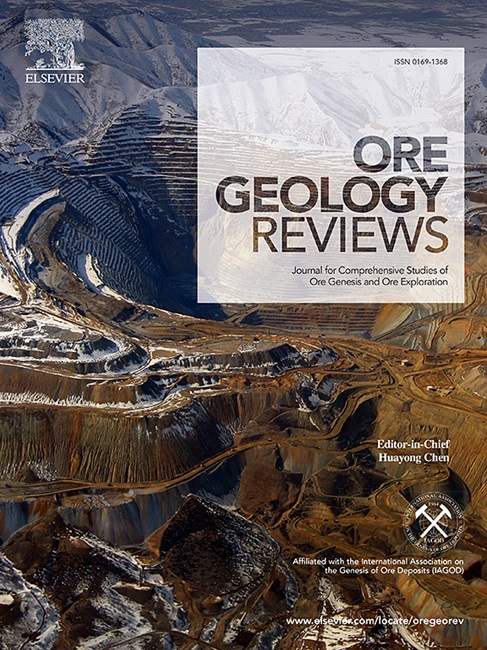藏东玉龙斑岩型铜钼矿床流体演化与金属沉淀机制——来自两期成矿作用的启示
IF 3.6
2区 地球科学
Q1 GEOLOGY
引用次数: 0
摘要
玉龙斑岩铜钼矿床是藏东始新世玉龙斑岩铜带中最大的矿床,保存了3次岩浆侵入引发的成矿事件。然而,尽管大多数Cu-Mo硫化物集中在前两个矿化阶段,但对这些阶段的压力-温度条件和金属沉淀机制仍然知之甚少。该研究综合了现场观测、矿石显微镜、阴极发光(CL)成像、流体包裹体显微测温以及硫化物硫同位素/辉钼矿Mo同位素耦合分析,以约束两个成矿阶段的成矿流体演化。第一阶段Cu-Mo矿化与岩石静力向流体静力过渡条件下(~ 450 bar)高温(~ 400-450°C) k -硅酸盐蚀变有关,这是由单相流体冷却引发的Cu-Mo直接沉淀造成的。II阶段成矿发生在静水压力(~ 300 bar)下,流体相分离为高盐度盐水和低盐度蒸汽,最终促进了广泛的Cu-Mo沉淀,并伴有中温绢云母蚀变(~ 350-400°C)。钼矿Mo同位素组成显示出明显的δ98/95Mo分馏(0.05 ~ 0.48‰),这可归因于二期成矿过程中多级流体沸腾和瑞利分馏作用。这些发现表明绢母岩蚀变叠加在钾硅酸盐蚀变上可作为高品位成矿带的标志。蚀变晕(富集重δ98/95Mo)中Mo同位素的系统变化为定位成矿中心提供了新的矢量工具。本文章由计算机程序翻译,如有差异,请以英文原文为准。

Fluid evolution and metal precipitation mechanisms in the Yulong porphyry Cu-Mo deposit, Eastern Tibet: insights from the two-stage mineralization process
The Yulong porphyry Cu-Mo deposit, the largest deposit in the Eocene Yulong porphyry copper belt of eastern Tibet, China, preserves three mineralization events triggered by multiple magmatic intrusions. Despite most Cu-Mo sulfides being concentrated in the first two mineralization stages, however, the pressure–temperature conditions and metal precipitation mechanisms of those remain poorly constrained. This study integrates field observations, ore microscopy, cathodoluminescence (CL) imaging, fluid inclusion microthermometry, and coupled sulfide sulfur isotope/molybdenite Mo isotope analyses to constrain ore-forming fluids evolution during two mineralization stages. Stage I Cu-Mo mineralization was associated with high-temperature (∼400–450 °C) K-silicate alteration under lithostatic to hydrostatic transitional conditions (∼450 bar), resulting from direct Cu-Mo precipitation triggered by cooling of single-phase fluids. Stage II mineralization occurred under hydrostatic pressure (∼300 bar), where fluid phase separation into high-salinity brine and low-salinity vapor ultimately facilitated extensive Cu-Mo precipitation accompanied by moderate-temperature sericitic alteration (∼350–400 °C). Mo isotopic compositions of molybdenite reveal pronounced δ98/95Mo fractionation (0.05 to 0.48 ‰) attributable to multistage fluid boiling and Rayleigh fractionation during Stage II mineralization. These findings establish that the overprinting of sericitic alteration on K-silicate alteration could serve as an indicator for high-grade mineralization zone. Systematic Mo isotopic variations in alteration halos (enriched in heavy δ98/95Mo) provide a novel vectoring tool to locate mineralization centers.
求助全文
通过发布文献求助,成功后即可免费获取论文全文。
去求助
来源期刊

Ore Geology Reviews
地学-地质学
CiteScore
6.50
自引率
27.30%
发文量
546
审稿时长
22.9 weeks
期刊介绍:
Ore Geology Reviews aims to familiarize all earth scientists with recent advances in a number of interconnected disciplines related to the study of, and search for, ore deposits. The reviews range from brief to longer contributions, but the journal preferentially publishes manuscripts that fill the niche between the commonly shorter journal articles and the comprehensive book coverages, and thus has a special appeal to many authors and readers.
 求助内容:
求助内容: 应助结果提醒方式:
应助结果提醒方式:


